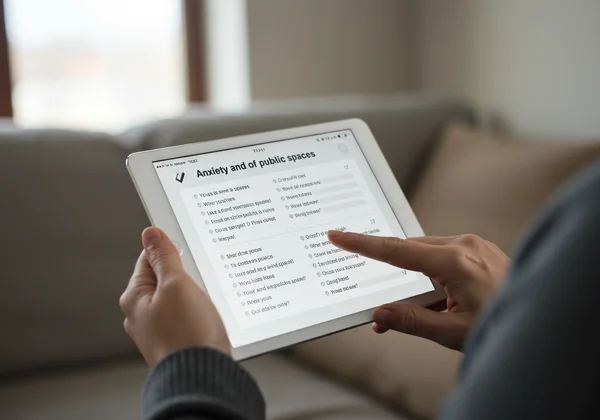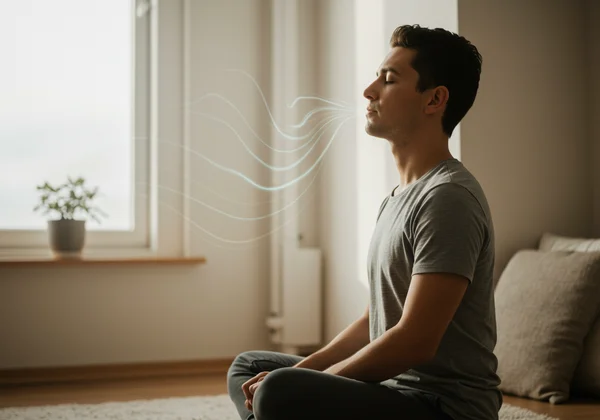Agoraphobia Test & Self-Help: 7 Daily Strategies to Cope
Feeling overwhelmed by agoraphobia can make daily life a struggle, but you are not alone. This condition, characterized by an intense fear of situations where escape might be difficult, can shrink your world until it feels confined to just a few "safe" places. But there is hope. This guide offers practical, evidence-based self-help strategies that can empower you to manage symptoms and gradually reclaim your freedom. How do I tell if I'm developing agoraphobia? Understanding the signs is the first step, and learning to cope is the next.
Discover tangible steps you can take today to manage agoraphobia and begin your journey toward recovery. A great starting point is gaining clarity on your symptoms. You can take the first step with a confidential online agoraphobia test designed to provide a preliminary assessment of your experiences.

Understanding Agoraphobia: The Daily Challenge
For many, living with agoraphobia is more than just avoiding crowds; it's a constant, exhausting negotiation with fear. Every potential outing, from a trip to the grocery store to visiting a friend, is weighed against the possibility of triggering overwhelming anxiety or a panic attack. This daily challenge can lead to significant isolation and impact relationships, work, and overall well-being.
What is life like living with agoraphobia?
Life with agoraphobia often involves a pattern of avoidance. You might find yourself turning down invitations, making excuses, or arranging your entire life to avoid specific triggers. These can include public transportation, open spaces like parking lots, enclosed spaces like theaters, standing in line, or being in a crowd. The core fear is often not of the place itself, but of having a panic attack in that place and being unable to escape or get help. This constant vigilance is mentally draining and can make you feel trapped, not by four walls, but by your own anxiety. Understanding your unique agoraphobia symptoms is crucial for managing them.

Can you be agoraphobic and still leave the house?
Absolutely. Agoraphobia exists on a spectrum. Some individuals may be completely housebound, while others can manage certain outings, often with great difficulty or by following strict routines. You might be able to go to work but avoid social events, or you might only leave the house with a trusted companion. The presence of agoraphobia isn't defined by whether you can leave your home, but by the intense fear and anxiety you experience when you do, and the extent to which that fear limits your life. An online agoraphobia test can help you understand where you might fall on this spectrum.
Foundational Self-Help Skills for Agoraphobia Recovery
Beginning the path to agoraphobia recovery starts with building a toolkit of foundational skills. These techniques are designed to help you manage anxiety in the moment, giving you a greater sense of control when fear starts to rise. Consistent practice is key to making these skills second nature.
Mastering Breathing and Grounding Techniques
When panic sets in, your breathing often becomes rapid and shallow, fueling the physical sensations of fear. Learning to control your breath is a powerful tool for anxiety management.
-
Box Breathing: Inhale slowly for four counts, hold your breath for four counts, exhale slowly for four counts, and then hold for four counts. Repeat this cycle until you feel your heart rate begin to slow.
-
5-4-3-2-1 Grounding: When your mind is racing, bring your focus to your senses. Name five things you can see, four things you can feel, three things you can hear, two things you can smell, and one thing you can taste. This pulls your attention away from internal fear and into the present moment.

Practicing Mindfulness for Managing Anxiety Symptoms
Mindfulness is the practice of observing your thoughts and feelings without judgment. Instead of fighting anxious thoughts, you acknowledge them as temporary mental events and let them pass. This contributes to your overall mental well-being. Start by sitting quietly for a few minutes each day, focusing on your breath, and gently redirecting your attention back to it whenever your mind wanders. This practice builds resilience against the overwhelming power of anxiety.
Gradually Expanding Your Comfort Zone
Learning how to beat agoraphobia is not about eliminating fear overnight, but about gradually teaching your brain that you are safe. This process, known as exposure, is a cornerstone of effective agoraphobia treatment and can be adapted for self-help.
Implementing Gentle Graded Exposure (Step-by-Step Progress)
Graded exposure involves creating a hierarchy of feared situations, from least scary to most scary, and tackling them one by one. Start small. If leaving the house is a major challenge, your first step might be simply standing on your doorstep for one minute. Once that feels manageable, you might walk to the end of your driveway. The goal is to stay in the situation long enough for the initial wave of anxiety to decrease, proving to yourself that you can handle it. This is a core principle in many forms of agoraphobia treatment.
Building Your Trusted Support System and Safe Spaces
Recovery is not a journey you have to take alone. Identify a trusted friend, family member, or partner who can support you. This person can accompany you during your initial exposure exercises, providing encouragement and a sense of security. Additionally, cultivate a mental "safe space"—a detailed, calming scene in your mind you can retreat to when you feel overwhelmed.
Cultivating a Mindset for Lasting Agoraphobia Relief
Your thoughts have a profound impact on your feelings and behaviors. A key part of agoraphobia self help involves learning to identify and challenge the cognitive distortions that fuel the cycle of fear and avoidance.
Challenging Negative Thought Patterns About Public Spaces
Agoraphobia is often maintained by "what if" thinking: "What if I have a panic attack?" "What if I can't escape?" These negative thought patterns can feel convincing, but they are often exaggerated. When you notice a fearful thought, challenge it. Ask yourself:
- What's the evidence for this thought?
- What's a more realistic outcome?
- What would I do if the worst-case scenario did happen? Often, you'll find that you are more capable of coping than your anxiety leads you to believe.
The Power of Self-Compassion in Your Recovery Journey
It's easy to get frustrated with yourself when progress feels slow. However, self-criticism only adds another layer of stress. Practice self-compassion by treating yourself with the same kindness you would offer a friend. Acknowledge that recovery is challenging and celebrate small victories. Remind yourself that setbacks are a normal part of the process, not a sign of failure.
When to Seek Professional Guidance for Agoraphobia
Self-help strategies are powerful, but they have their limits. Knowing when to reach out for professional support is a sign of strength and a critical step toward lasting recovery.
Recognizing the Limits of Self-Help and When to Get Help
If your symptoms are severely impacting your ability to function daily, if self-help techniques aren't providing enough relief, or if you're struggling with co-occurring issues like depression, it's time to seek professional help. A therapist can provide evidence-based treatments like Cognitive Behavioral Therapy (CBT), which is highly effective for agoraphobia.

How an Agoraphobia Self-Assessment Can Guide Your Next Steps
Before you even speak to a professional, understanding the nature of your symptoms can be incredibly empowering. This is where an agoraphobia self-assessment becomes an invaluable tool. It provides a structured way to reflect on your experiences and gives you a clear, tangible summary of your potential risk level. Taking a quick, free, and confidential agoraphobia screening test can provide the clarity needed to have a more informed conversation with a doctor or therapist, guiding your next steps effectively.
Your Next Steps Towards Freedom
Taking the first steps to manage agoraphobia can feel daunting, but with these self-help strategies, you have powerful tools at your disposal. From mastering your breath to gently expanding your world, each small action is a victory. Remember, understanding your symptoms is the key to effective coping. The journey to reclaim your freedom begins with a single, informed step.
Consider taking our free, confidential agoraphobia test today to gain clarity and guide your next steps towards a more fulfilling life. Start your journey now and empower yourself with knowledge.
Frequently Asked Questions About Agoraphobia Self-Help
How Do You Test For Agoraphobia?
A formal diagnosis of agoraphobia must be made by a qualified healthcare professional, like a psychologist or psychiatrist, based on criteria from diagnostic manuals such as the DSM-5. However, a great first step is using a screening tool. An online agoraphobia test asks questions about your reactions to specific situations to give you a preliminary risk assessment. This can help you decide if you should seek a professional evaluation. You can try our free tool to get started.
What Are The Levels Of Agoraphobia?
Agoraphobia is best understood as a spectrum of severity. Some people may experience mild anxiety that causes them to avoid only a few specific situations. Others may have moderate agoraphobia, where their daily life is significantly restricted. In severe cases, a person may be unable to leave their home at all. A confidential self-assessment can help you understand the potential intensity of your symptoms.
What Not To Do When Managing Agoraphobia?
When managing agoraphobia, it's crucial to avoid complete withdrawal and isolation, as this reinforces the fear. Don't rely on unhealthy coping mechanisms like alcohol or drugs. It's also important not to be too hard on yourself; avoid self-criticism and understand that recovery is a gradual process with ups and downs. Most importantly, do not ignore your symptoms—taking proactive steps, like seeking information and support, is essential.